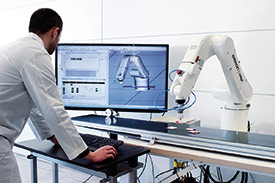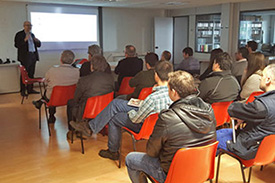Transformamos en realidad las expectativas de nuestros clientes
Desde nuestra fundación en 1989, TECNICAL se ha consolidado como un referente en ingeniería de control y automatización industrial. Nuestra firma se distingue por ofrecer soluciones de vanguardia en el campo de la automatización industrial y las infraestructuras.
”Más...”
Nuestro compromiso principal es convertir en realidad las expectativas de nuestros clientes, lo que se traduce en costos altamente competitivos y un nivel de calidad inigualable. Con más de treinta años de experiencia, hemos forjado una reputación basada en la confianza y el cumplimiento.
Una parte esencial de los éxitos alcanzados reside en nuestro valioso equipo humano, que actualmente supera los 50 profesionales distribuidos en áreas clave como Ingeniería, Logística, Ventas y Administración. En particular, nuestra sólida división de Ingeniería incluye más de 20 ingenieros e ingenieras con una vasta experiencia, siendo este un departamento fundamental de nuestra empresa.
En TECNICAL, hemos evolucionado con el tiempo para abrazar los cambios y desafíos de la industria y continuamos comprometidos en proporcionar soluciones de automatización de primer nivel que impulsan el progreso en la ingeniería industrial moderna. Confiad en nosotros para ofrecer eficiencia, calidad y experiencia en cada proyecto.
”Menos”

En Tecnical, lideramos la automatización y robótica industrial al incorporar tecnología de vanguardia en hardware, software, ingeniería de control y redes de comunicación industrial. Nuestro enfoque es claro: diseñar sistemas productivos que alcancen los estándares más exigentes en términos de eficiencia, seguridad y óptimo desempeño. Cada sistema que creamos está diseñado meticulosamente para mantener la productividad en niveles óptimos. Comprendemos a fondo los desafíos que los retrasos en la producción pueden presentar para su empresa. Por esta razón, nos comprometemos a ofrecer soluciones innovadoras y competitivas que aseguren un funcionamiento fluido de sus operaciones.
Nuestro enfoque implica un análisis exhaustivo de cada proceso de producción, y desarrollamos soluciones personalizadas desde la etapa de diseño hasta la instalación y puesta en marcha. En Tecnical, respalda nuestra experiencia de más de 30 años en el sector, y estamos decididos a seguir siendo pioneros en la automatización y robótica industrial para el beneficio continuo de nuestros clientes.
Proyectos de ingeniería y distribución de productos para la automatización
En Tecnical trabajamos en dos grandes bloques, los proyectos de ingeniería y la distribución de material para la automatización industrial.
Distribuimos las mejores marcas
Con una amplia experiencia, estamos capacitados para asesorarte tanto en aspectos técnicos como comerciales en tus proyectos y suministros. Ofrecemos un servicio profesional adaptado a tus necesidades.
Nos especializamos en todo lo que se requiere para automatizar un proceso y contamos con un equipo de profesionales cualificados en los diferentes campos de la automatización. Disponemos de una tienda para la atención al público y de un almacén especializado para gestionar la logística de tus pedidos programados o entregas inmediatas.
Distribuimos miles de productos de referencia con documentación técnica asociada y contamos con el apoyo de nuestro equipo técnico y comercial, que está a tu disposición para el desarrollo de tus proyectos.
Proyectos personalizados y a medida
En Tecnical, somos expertos en brindar soluciones de automatización de alto valor añadido. Nos dedicamos al diseño y a la implementación de sistemas de alto rendimiento, buscando siempre resolver las necesidades de nuestros clientes. Nos respalda una experiencia de más de 30 años, acompañando a nuestros clientes en la mejora de sus sistemas, procesos y proyectos de automatización. Esta vasta trayectoria se convierte en una de nuestras mayores garantías.
Ofrecemos servicios de ingeniería industrial multidisciplinarios tanto para proyectos nuevos como para actualizaciones de sistemas existentes. Desde la etapa de ingeniería hasta la operación y las pruebas, nuestro equipo se coordina para lograr un rendimiento óptimo. Esto se traduce en una mayor productividad, competitividad y sostenibilidad, en el complejo entorno de la producción industrial contemporánea.
En Tecnical, estamos comprometidos con la excelencia en la automatización y la ingeniería industrial. Nuestro equipo de expertos se encuentra disponible para atender tus necesidades en nuestras cuatro sedes ubicadas estratégicamente en Manresa, Igualada, Ripoll y Lleida.
No dudes en ponerte en contacto con nosotros para discutir tus proyectos, desafíos o cualquier consulta técnica que puedas tener. Valoramos tu búsqueda de la excelencia y estamos listos para brindarte nuestro conocimiento y experiencia. Tu futuro en la automatización industrial comienza aquí.
Cobots: Soluciones industriales Omron
Introducción a la Automatización Colaborativa con Omron [...]
Sistemas de visión artificial: Tecnical y SICK AG
Sistemas de visión artificial En un mundo donde [...]
Conectividad y automatización con Weidmüller España y Tecnical
Weidmüller España con Tecnical En un mundo donde [...]
¡CONTACTE CON TECNICAL!
¿Le gustaría solicitar un presupuesto detallado o simplemente solicitar más información?





















